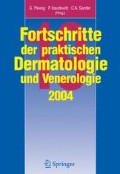Zusammenfassung
Keratinfilamente sowie desmosomale und hemidesmosomale Strukturproteine sind von zentraler Bedeutung für die Zell-Zell-Adhäsion und Zell-Matrix-Adhäsion innerhalb von Epidermis und dermo-epidermaler Junktionszone. Mutationen der Keratinfilamente sowie desmosomaler und hemidesmosomaler Strukturproteine finden sich bei hereditären Epidermolysen, epidermolytischen Hyperkeratosen, Ichthyosen und Palmoplantarkeratosen. Daneben können desmosomale und hemidesmosomale Strukturproteine das Zielantigen von Autoantikörpern bei verschiedenen Pemphigus- und Pemphigoid-Erkrankungen sowie der Epidermolysis bullosa acquisita darstellen. Viele der heute bekannten desmosomalen und hemidesmosomalen Strukturproteine wurden durch Autoantikörper von Patienten mit bullösen Autoimmundermatosen charakterisiert. Hereditäre und autoimmunologische blasenbildende Erkrankungen haben daher wesentlich zu unserem heutigen Verständnis der Biologie der Haut beigetragen.
Access this chapter
Tax calculation will be finalised at checkout
Purchases are for personal use only
Preview
Unable to display preview. Download preview PDF.
Literatur
Borradori L, Sonnenberger A (1999) Structure and function of hemidesmosomes: more than simple adhesion complexes. J Invest Dermatol 112: 411–418
Chan LS, Ahmed AR, Anhalt GJ, Bernauer W, Cooper KD, Elder MJ, Fine JD, Foster CS, Ghohestani R, Hashimoto T, Hoang-Xuan T, Kirtschig G, Korman NJ, Lightman S, Lozada-Nur F, Marinkovich MP, Mondino BJ, Prost-Squarcioni C, Rogers RS 3rd, Setterfield JF, West DP, Wojnarowska F, Woodley DT, Yancey KB, Zillikens D, Zone JJ (2002) The first international consensus on mucous membrane pemphigoid: definition, diagnostic criteria, pathogenic factors, medical treatment and prognostic indicators. Arch Dermatol 138: 370–379
Franzke CW, Tasanen K, Schäcke H, Zhou Z, Tryggvason K, Mauch C, Zigrino P, Sunnarborg S, Lee DC, Fahrenholz F, Bruckner-Tuderman L (2002) Transmembrane collagen XVII, an epithelial adhesion protein, is shed from the cell surface by ADAMs. EMBO J 21: 5026–5035, 2002
Georgi M, Jainta S, Bröcker EB, Zillikens D (2001) Autoantigene subepidermal Blasen bildender Autoimmundermatosen. Hautarzt 52: 1079–1089
Hertl M, Schuler G (2002) Klassifikation und Pathogenese bullöser Autoimmundermatosen. Hautarzt 53: 207–221
Schmidt E, Bröcker EB, Zillikens D (2000) Pemphigus: Verlust des desmosomalen Zell-Zell-Kontaktes. Hautarzt 51: 309–318
Schmidt E, Zillikens D (2000) Autoimmune and inherited subepidermal blistering diseases: advances in the clinic and the laboratory. Adv Dermatol 16: 113–157
Shimanovich I, Mihai S, Oostingh GJ, Ilenchuk TT, Brocker EB, Opdenakker G, Zillikens D, Sitaru C (2004) Granulocyte-derived elastase and gelatinase B are required for dermal-epidermal separation induced by autoantibodies from patients with epidermolysis bullosa acquisita and bullous pemphigoid. J Pathol 204: 519–527
Shimanovich I, Rose C, Hirako Y, Butt-Dörje E, Zillikens D (2004) Anti-p200-Pemphigoid — Eine neue blasenbildende Autoimmundermatose. JDDG 2: 7–14
Sitaru C, Kromminga A, Hashimoto T, Bröcker EB, Zillikens D (2002) Autoantibodies to type VII collagen mediate fcγ-dependent neutrophil activation and induce dermalepidermal separation in cryosections of human skin. Am J Pathol 161: 301–311
Author information
Authors and Affiliations
Editor information
Rights and permissions
Copyright information
© 2005 Springer-Verlag Berlin Heidelberg
About this paper
Cite this paper
Zillikens, D. (2005). Epidermale Struktur- und Adhäsionsmoleküle. In: Plewig, G., Kaudewitz, P., Sander, C.A. (eds) Fortschritte der praktischen Dermatologie und Venerologie. Fortschritte der praktischen Dermatologie und Venerologie, vol 19. Springer, Berlin, Heidelberg. https://doi.org/10.1007/3-540-28691-8_2
Download citation
DOI: https://doi.org/10.1007/3-540-28691-8_2
Publisher Name: Springer, Berlin, Heidelberg
Print ISBN: 978-3-540-21055-9
Online ISBN: 978-3-540-28691-2
eBook Packages: Medicine (German Language)

